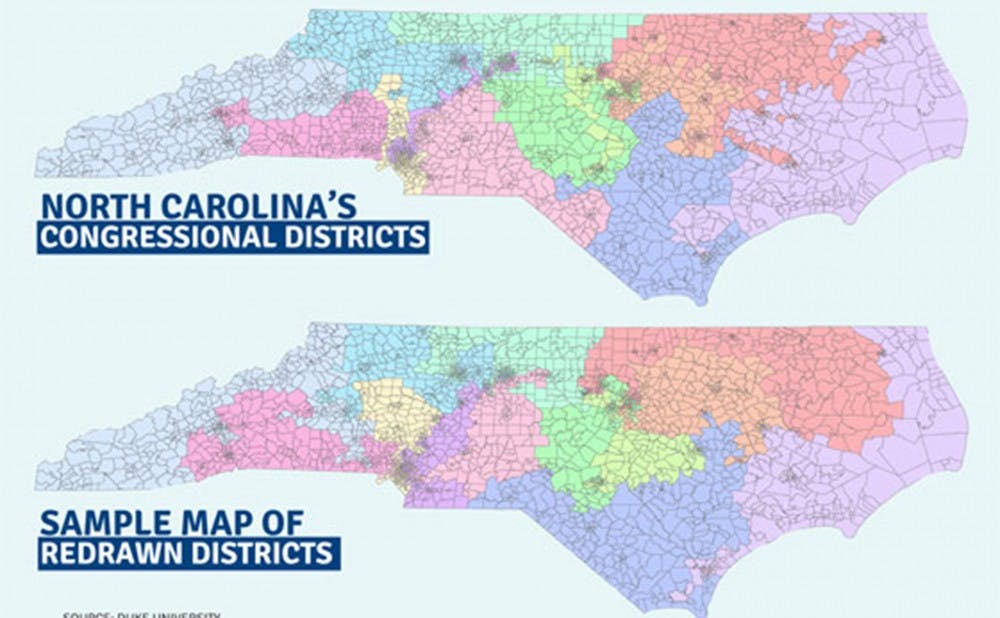Facing allegations of racial gerrymandering, the North Carolina legislature has little time until the June 7 congressional primary election to reach a bipartisan agreement on congressional district lines.
On Feb. 19, The Supreme Court upheld a lower court’s ruling that forced the legislature to draw up a new election district map for congressional seats in order to eliminate racial gerrymandering in two districts. Of the 13 U.S. House of Representatives seats allocated to North Carolina, 10 are currently taken by Republicans and three by Democrats. Before the congressional elections, the districts must be redrawn again so that there is not an evident electoral advantage for either party, although legislators and scholars believe a successful compromise is unlikely.
“The major implications would be that the Republicans are likely to translate even a 50-50 tie in votes into a substantial majority with the way in which districts are drawn,” said John Aldrich, Pfizer-Pratt University professor of political science, about the current 10-to-3 ratio of Republican to Democratic districts. “That is what has happened in the past and what can happen with current redistricting.”
Aldrich explained that District 1 and District 12, which are both led by Democratic representatives, were designed in the 1990s to have a majority of black voters.
“What has happened over time is that not only was this a majority-minority district, but the Republicans packed a large number of voters who are all going to vote for Democrats into District 1 so there are fewer of them in surrounding areas,” Aldrich said.
David Price, a Democratic representative for District 4, carries his district with an approximately 70 percent Democratic voter base. Aldrich contends that Price’s district, along with the first and 12th districts, will remain Democratic due to the disproportionate number of Democrats compacted in those three districts.
Opponents of the Republicans’ redrawn congressional districts articulated that the party was attempting to pack black voters into two districts, with the remainder of the districts primarily white and in favor of the GOP, Aldrich explained. Opponents of the plan are advocating for the lines to be redrawn so that the proportion of Democrats is more equitably spread—therefore allowing for both parties to be competitive in elections.
The state legislature has moved the North Carolina congressional primary election to June, but it remains unclear as to whether or not a revised plan will be accepted by then. State governments may appeal the new plan, which would lead to a hearing by the Supreme Court.
North Carolina General Assembly Representative Graig Meyer, a Democrat representing Durham and Orange County, explained that under the current districts, some voters who used to be in one district were moved to new districts, sometimes with different representatives than the one they initially voted for.
“The biggest change for Durham county specifically is that Durham county has now been made into only two congressional districts, whereas previously it was four congressional districts,” Meyer said.
Dallas Woodhouse, executive director of the North Carolina Republican Party, argued that by holding separate primaries for Congress and for the presidential nomination, which occurs March 15, voter turnout decreases and uninformed voters are disadvantaged.
“I think that the effect of the Democrats and their allies is to ultimately disenfranchise tons of people,” Woodhouse explained. “Somewhere in the neighborhood of 800,000 people voted in the traditional primaries and only 161 in the Congressional primaries.”
Republicans contend that the previously rejected congressional district boundaries have always been drawn to comply with the Voting Rights Act of 1965 and that the issue is obsolete, Woodhouse noted.
“What the Court did is virtually unprecedented to stop an election that was virtually underway with hundreds of thousands of absentee ballots already printed and many ballots already returned to the appropriate boards of elections,” Woodhouse said.
Get The Chronicle straight to your inbox
Signup for our weekly newsletter. Cancel at any time.

